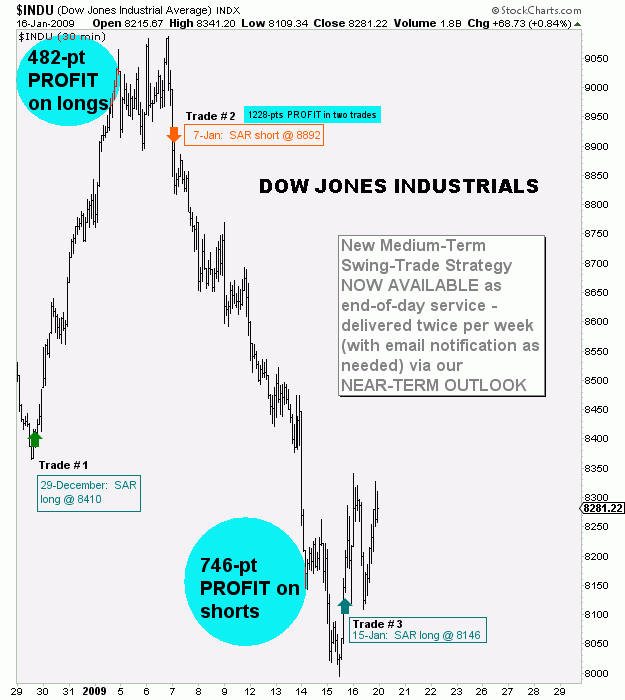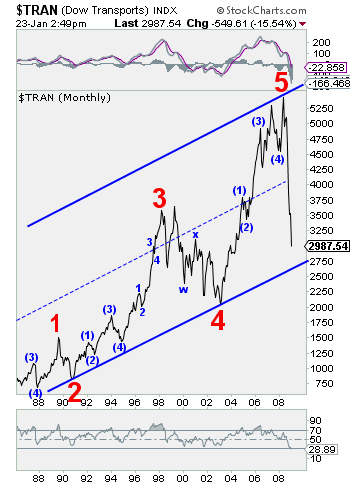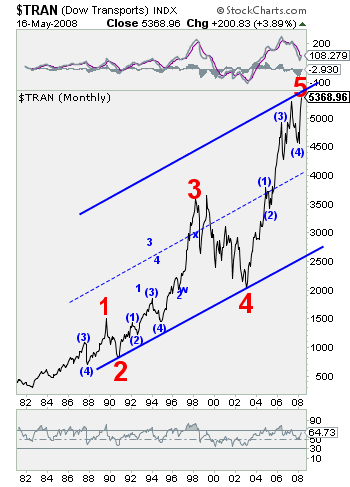Dow Jones Index Stocks Bear Market Update
Stock-Markets / Stocks Bear Market Jan 24, 2009 - 10:59 AM GMTBy: Joseph_Russo

 Last week we took a close look at the November low, and reviewed the price action since then relative to extremely short-term trading tactics. Later in this piece, after taking a retrospective look back at the Transportation average, we will explore some merits and challenges associated with executing medium-term speculative strategies. The small chart plots three months of daily closes for the Dow Jones Industrials. It shows that the move up toward the January high was clearly corrective.
Last week we took a close look at the November low, and reviewed the price action since then relative to extremely short-term trading tactics. Later in this piece, after taking a retrospective look back at the Transportation average, we will explore some merits and challenges associated with executing medium-term speculative strategies. The small chart plots three months of daily closes for the Dow Jones Industrials. It shows that the move up toward the January high was clearly corrective.
 The chart now illustrates that the rapid decline off the January peak has breached a key 61.8% Fibonacci retracement level on a closing basis. From here, we now have a tentative working low in January from which to observe the near-term course of price action. In light of this prospect, we have added a new set of “upward” Fibonacci retracement levels should this working low hold bottom. The first level of .382 upward resistance is near the 8350 level, followed by 8500 and 8600, which mark the .500 and .618 upward fibs. Subsequent reaction to potential rallies reaching any of these three levels will provide clarity to the unfolding wave structures. If the Dow sternly rejects any such advances, fresh new bear market lows will not be far behind.
The chart now illustrates that the rapid decline off the January peak has breached a key 61.8% Fibonacci retracement level on a closing basis. From here, we now have a tentative working low in January from which to observe the near-term course of price action. In light of this prospect, we have added a new set of “upward” Fibonacci retracement levels should this working low hold bottom. The first level of .382 upward resistance is near the 8350 level, followed by 8500 and 8600, which mark the .500 and .618 upward fibs. Subsequent reaction to potential rallies reaching any of these three levels will provide clarity to the unfolding wave structures. If the Dow sternly rejects any such advances, fresh new bear market lows will not be far behind.
Remember When the Trannies were Hitting ALL-TIME-HIGHS
We do. As promised back in May of 2008, below are two charts revisiting outcome of our comprehensive Elliott Wave analysis of the Transportation average. Without equivocation, “then & now” snapshot charts from those originally studied in our Transports Hitting All-Time Highs piece, provides testament to the universal power of Elliott's principles.
Bridging the Speculative Time-Horizon Gap
Relative to last week's discussion on the cyclicality of short-term trading strategy performance, we thought it prudent to visit the merits and challenges associated with speculating amid the medium-term time-horizon.
Although our proprietary short-term trading models are fabulous, many of our users do not have the time or inclination to observe 30-minute price charts throughout the entirety of each trading session. For this more moderate type of speculator, we now provide a daily pre-open medium-swing market summary on the Dow, S&P, and NDX indices.
Building on the powerhouse trading strategies provided within our publications, we call our most recent, the (NTST) Near-Term Swing-Trade Strategy. Relative to the extreme short-term nature of our (IP) & (MV) strategies, which can generate multiple signals daily, the Near-Term Swing Trade strategy intends stay with positions for as much of a “short-term” move as possible.
In broad terms, this “medium” pivot approach is still very much a short-term strategy, and as such, it requires the perspective of intraday price bars in order to derive optimal entry and exit signals. Signals can occur numerous time per week when probing for tradable tops and bottoms, and once elected, trades may last anywhere from one day, to weeks depending on one's discretionary exit preferences.
We monitor (NTST) strategic posture, entries, stops, and exits on a daily basis, and make them available through our daily subscription service. Should opportunities arise between publications, we also provide email notifications conveying any adjustments or changes to our current tactical stance.
Not Quite Spoon-Fed
Without the need to monitor intraday charts for (MV) manic pivots or (IP) interim pivots, the Near-Term Swing Trade approach allows speculators the freedom and opportunity to capture the lion's share of “medium” pivots without having to watch and react to every tick. Entry levels, opening stops, trailing stops, and exit levels are all delivered on a silver platter. The (NTST) is by no means a Holy Grail, nothing is, but it just may be the right solution for those lacking the time to roll-up their sleeves and do battle in the challenging trenches of day-trading warfare. Despite all of this convenience, (NTST) traders are required to engage in the daily review of charts, risk assessments, and must take full responsibility for their individual position and money management accountabilities.

The (NTST) Strategy in Action
Although intentionally void of proprietary signal indicators, wave-counts, price-targets, and directional assumptions, the chart above reflects outcome relative to the profitability and precision that this strategy is capable of producing.
In three trades spanning over a two-week period, the strategy delivered 1228-pts in profit for an astounding 14.4% return. We achieved even greater outcomes for the S&P, and NDX. The S&P clocked in with 142-pts while the NDX brought in 190-pts profit, both yielding a 16% two-week return. Despite the impressive results, we caution traders not to get too excited. As with any strategy, this one also comes with its fair share of challenge and risk. Though the author exercises patient discipline in administering guidance in order to mitigate risk, losses can and will occur with certainty. Case in point being trade # 3 issued on 15-January. This SAR (stop and reverse) long call near the 8146 level stopped-out for a 63-pt LOSS the day after issuance. We must always remind ourselves that prudent speculation involves the willingness to take measured risk in return for comparable rewards. When we get this concept ingrained in our heads, we then have half of what it takes to be successful. The other half comes from good guidance, hard work, and the prudential management of money and risk.
The Complete Speculative Landscape
In our total commitment to keep one-step ahead of the entire speculative process, we go to great lengths in continually plotting course of the entire trading map for all time horizons. Doing so enables us to assess which strategies are currently working, which are muddling through, and which are languishing. Maintaining impartial resolve to such discipline allows us to deliver large profits without self-aggrandizement, and engender caution where necessary to stem losses amid situations of challenge.
 Trade the Super-Cycle IV -Wave
Trade the Super-Cycle IV -Wave
To safely speculate on, and effectively trade the endless array of unfolding subdivisions forthcoming in SC-IV, one may subscribe to our premium technical publication.
The express focus of Elliott Wave Technology's Near Term Outlook is to help active traders anticipate price direction and amplitude of broad market indices over the short, intermediate, and long-term.
Over the past three years, we continue to hone the art of dispatching tactical trade set-ups and market forecasting into a consistent, impartial, and immensely rewarding endeavor for those who take the time to embrace it.
We deliver this unique blend of proprietary charting protocol daily, with the express intent to convey timely and profitable information. Our daily reports impart strategy-specific guidance , which strives to calibrate market impact relative to a multitude of trading signals that are in direct alignment with distinct speculative strategies set forth in the members NTO essentials file.
Regardless of one's level of trading experience, users must allow sufficient time to become acquainted with the authors charting protocol, strategies, and tactical narratives prior to entering positions or developing discretionary trading strategies of their own. Our forthcoming E-letters should assist greatly in this endeavor.
Communications in store for 2009: To more effectively convey dynamic trading conditions relevant to our technical publications; we are soon planning to launch complimentary E-letter briefings for anyone interested in following our work. E-letter dispatches will briefly summarize tactical trading postures across various time horizons and trading strategies. The theme of our maiden E-letter will reveal how to sell at major tops, and buy at critical bottoms. Those interested may email us to get an early seat on our mailing list.
Trade Better / Invest Smarter...
By Joseph Russo
Chief Editor and Technical Analyst
Elliott Wave Technology
Email Author
Copyright © 2009 Elliott Wave Technology. All Rights Reserved.
Joseph Russo, presently the Publisher and Chief Market analyst for Elliott Wave Technology, has been studying Elliott Wave Theory, and the Technical Analysis of Financial Markets since 1991 and currently maintains active member status in the "Market Technicians Association." Joe continues to expand his body of knowledge through the MTA's accredited CMT program.
Joseph Russo Archive |
© 2005-2022 http://www.MarketOracle.co.uk - The Market Oracle is a FREE Daily Financial Markets Analysis & Forecasting online publication.




